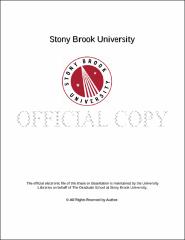| dc.identifier.uri | http://hdl.handle.net/11401/77594 | |
| dc.description.sponsorship | This work is sponsored by the Stony Brook University Graduate School in compliance with the requirements for completion of degree. | en_US |
| dc.format | Monograph | |
| dc.format.medium | Electronic Resource | en_US |
| dc.language.iso | en_US | |
| dc.publisher | The Graduate School, Stony Brook University: Stony Brook, NY. | |
| dc.type | Dissertation | |
| dcterms.abstract | Visual search is the task of finding something with an uncertain location. Much research has been done on the features used in visual search, but most previous work has used only simple stimuli, like colored bars. Although people debate the features of even simple stimuli, most researchers agree that hue, shape, and orientation are important for guiding search. This study tested the role of hue, shape, and orientation in how we search for real-world objects, and estimates the importance of these features, both separately and in combination, and relates this importance to how reliably each feature defines the target. Nine experiments were conducted in order to describe mismatch effects, in which a decrease in performance is caused by differences between the way a target looks when participants are told to search for it and the way it looks when they actually find it (if you're looking for a red car, but the car is actually blue, this will make your search harder, but only if you are using color as a guiding feature). These mismatch effects provide an indicator of how important each feature is in guiding search (with performance decrements increasing with mismatch for features that are important to the task), a means for testing effects of feature reliability (by varying the probability of mismatch in a given feature dimension), and the combination of mismatch effects across different features (by manipulating more than one dimension at a time). Results demonstrated that search is largely driven by color information and that shape and orientation are only used in guiding search when color is not available to perform the task. Mismatch effects were more pronounced when participants were uncertain of what feature dimension would change, suggesting that you are less likely to rely on features which are known to change. Mismatch effects with combinations of feature dimensions also demonstrate that the different feature dimensions do not sum linearly, though most models of visual search predict a linear sum. A number of modifications to current models of search are suggested so as to adequately account for these mismatch effects. | |
| dcterms.available | 2017-09-20T16:52:57Z | |
| dcterms.contributor | Leung, Hoi-Chung | en_US |
| dcterms.contributor | Zelinsky, Gregory J | en_US |
| dcterms.contributor | Williams, Carrick. | en_US |
| dcterms.contributor | Franklin, Nancy | en_US |
| dcterms.creator | Alexander, Robert G. | |
| dcterms.dateAccepted | 2017-09-20T16:52:57Z | |
| dcterms.dateSubmitted | 2017-09-20T16:52:57Z | |
| dcterms.description | Department of Experimental Psychology. | en_US |
| dcterms.extent | 91 pg. | en_US |
| dcterms.format | Monograph | |
| dcterms.format | Application/PDF | en_US |
| dcterms.identifier | http://hdl.handle.net/11401/77594 | |
| dcterms.issued | 2015-08-01 | |
| dcterms.language | en_US | |
| dcterms.provenance | Made available in DSpace on 2017-09-20T16:52:57Z (GMT). No. of bitstreams: 1
Alexander_grad.sunysb_0771E_11650.pdf: 1364498 bytes, checksum: 4c107fd9aff02183f4d28c750c0627a8 (MD5)
Previous issue date: 2013 | en |
| dcterms.publisher | The Graduate School, Stony Brook University: Stony Brook, NY. | |
| dcterms.subject | color, eye movements, orientation, shape, top-down target template, visual search | |
| dcterms.subject | Cognitive psychology | |
| dcterms.title | Guiding Features in Visual Search | |
| dcterms.type | Dissertation | |

